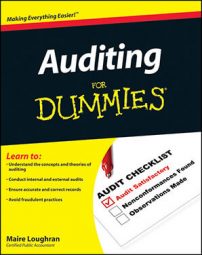When you perform an audit of a company, you have to account for that company’s tangible assets. You can find your audit client’s property, plant, and equipment in the asset section of its balance sheet. Here are some common types of property, plant, and equipment:
Buildings: These are the structures your client owns and does business in. They may include retail locations, factories, office buildings, warehouses, and storage facilities.
Land: Land includes the ground where the client’s buildings that it uses for its business are located. Any land the client has purchased for eventual development or for its appreciation value is classified as an investment. This is true even if the eventual development is for a business purpose structure.
Equipment: This category is very broad. Anything the company uses to make the products it sells is equipment. For example, a candy bar manufacturer would include mixers, ovens, and packaging machines.
Furniture and store fixtures: This category includes desks, chairs, and filing cabinets — all the common furniture items you find in any office. Examples of store fixtures are floor or wall display racks and glass cases that contain merchandise. Some businesses include cash registers with fixtures.
Except for the allocation of land and buildings, accounting for fixed-asset purchases is straightforward.
Now, what about accounting for purchases of land and buildings? The cost of the land a building sits on has to be separated from the building’s cost. Why? Generally Accepted Accounting Principles (GAAP) mandates that separation. Also, as a practical point, land isn’t depreciated under GAAP or for a company’s tax return.
However, land improvements like fences, roads, and gates are depreciable, and they should be shown as a separate line item on the balance sheet.
How do you figure out whether your client has appropriately broken out a purchase between the land and the building? If your client is a repeat customer and the purchase of the land and building took place in the past, your workpapers from the prior audit most likely show that the proper allocation was addressed and resolved in the past. If the purchase takes place in the year of audit, or if you’re working with a new client, the best verification is to have the client provide the appraisal that was done during the purchasing process.
An appraisal is a determination by a licensed professional of the value of real property (another name for real estate). Basically, the appraisal provides assurance to the mortgage company that you’re not borrowing more than the property’s worth. Even if a business doesn’t have to secure a mortgage to purchase a real property asset, it still gets an appraisal to make sure it’s not overpaying for the property. The county property tax records may show an allocation of building to land. However, that allocation is just for property tax purposes; it may not be materially correct for your audit. Luckily, you have an audit team leader ready to help and advise you. Ask him or her for guidance.
If your audit client purchases a piece of raw land and constructs its own building, this accounting issue is simple because you have a sales price for the land and construction costs for the building.

